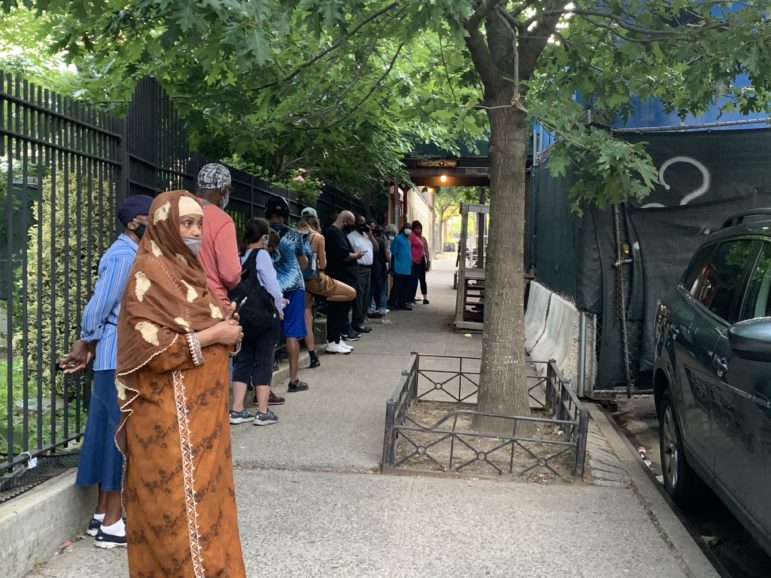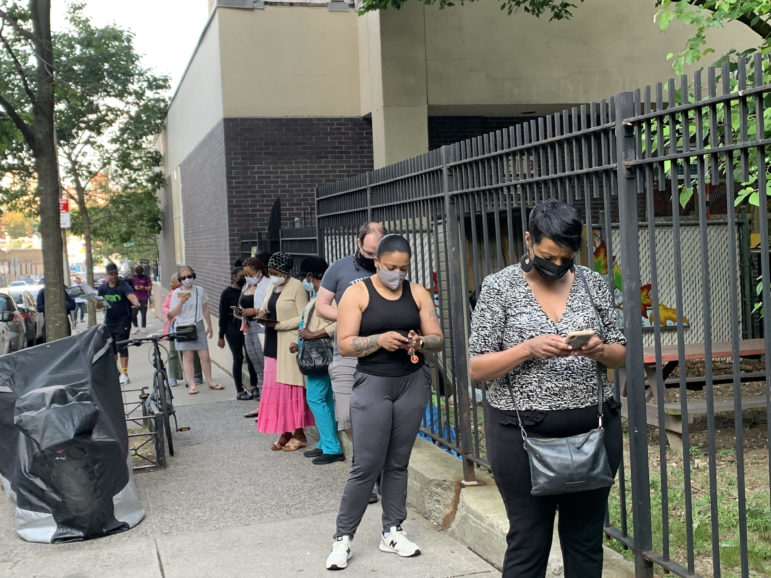The winner of the primary will go on to compete on the ballot in November’s general election—which in a city that leans as heavily Democratic as New York means most seats will be filled by whoever wins in June.
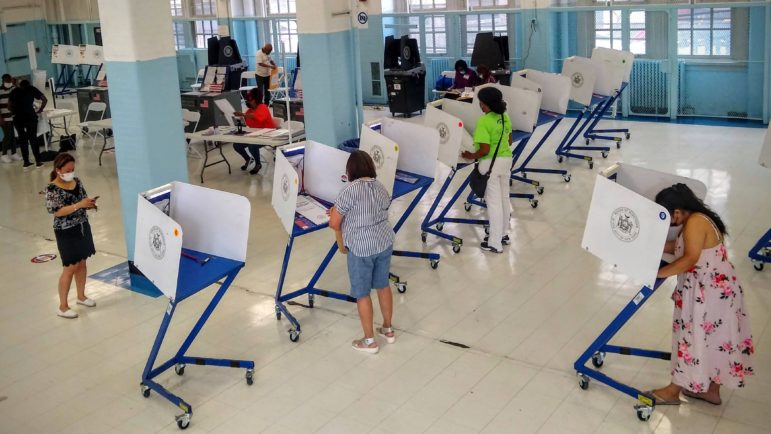
Adi Talwar
Voters at M.S. 80 at 149 East Mosholu Parkway in the Bronx.Tuesday is primary election day in New York City, where residents will choose candidates for mayor, comptroller, public advocate, borough presidents, City Council and more. The winner of the primary will go on to compete on the ballot in November’s general election—which in a city that leans as heavily Democratic as New York means most seats will be filled by whoever wins in June.
Poll sites will be open from 6 a.m. to 9 p.m. Look up your polling site address here. See who’s on your ballot here. For answers to other common voting questions, check these FAQs on the city Board of Elections website. City Limits’ reporters will out at the polls, and we’ll be updating this story throughout the day. Have a voting experience you want to tell us about? Email editor@citylimits.org and check out some of City Limits previous 2021 Election coverage:
- Coverage of the NYC mayoral race
- Mayoral Candidates & Family Homelessness: A Video Voters’ Guide
- Council Countdown: Coverage of the NYC Council races in partnership with Gotham Gazette, City & State and Queens Eagle
- Coverage of the borough presidents races
- Coverage of the NYC comptroller race
- Video Series: Issues in the 2021 Elections (Immigration, Aging, Transportation, Health, Housing, Education, Economy, Climate Change, Policing)
–Jeanmarie Evelly
Election Night Parties—And Waiting for Results

David Brand
Scenes from Andrew Yang’s election night party at Yotel hotel in Hell’s Kitchen.Polls closed at 9 p.m. Tuesday. But unlike past city elections, most races this year won’t have a winner declared for another few weeks as the Board of Elections undertakes the process of eliminating candidates/redistributing votes under the new ranked choice voting system—which will kick in for any race where no candidates earns at least 50 percent of votes off the bat—plus time to count absentee and affidavit ballots, among other processes required under election law.
As of 9:40 p.m., unofficial BOE results in the Democratic mayoral race showed Brooklyn Borough President Eric Adams leading, but that represented less than 2 percent of ballot scanning machines, making the numbers essentially moot. In the Republican race, Guardian Angels founder Curtis Sliwa was leading against cab industry advocate Fernando Mateo, with just over 11 percent of scanning machines reported around 10 p.m. (ranked choice voting won’t apply to the Republican primary, since just two candidates are competing).
While results aren’t imminent, the mayoral candidates weren’t holding off to party. Tech entrepreneur Andrew Yang’s campaign hosted festivities on the astroturf-lined outdoor bar atop at the the Yotel hotel on 10th Ave and 42nd Street.
Attorney Maya Wiley’s supporters gathered to celebrate at a purple-hued party room at KAI Studio in Brooklyn. Former Sanitation Commissioner Kathryn Garcia held her election night celebration at a revamped warehouse space in Bushwick, 99 Scott, where supporters drank and snacked in an adjacent plant bedecked backyard. The playlist included Prince, Journey and Elton John.
Adams’ party was at a disco-ball adorned club in Williamsburg called Schimanski. Just after the polls closed at 9 p.m., the DJ played Daft Punk’s “Get Lucky,” something Adams’ supporters— whose energy has been high so far—probably hope happens as election results become clearer in the days ahead.
Adams has led in recent polling, but the rollout of ranked-choice voting in this primary, a higher-than-normal turnout, and outstanding absentee and affidavit ballots may make this race more unpredictable than traditional primary elections.
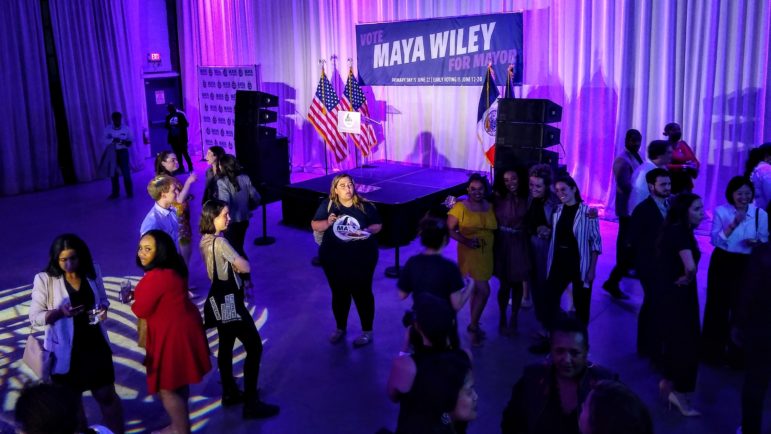
Attorney Maya Wiley’s campaign party at KAI Studio in Brooklyn. 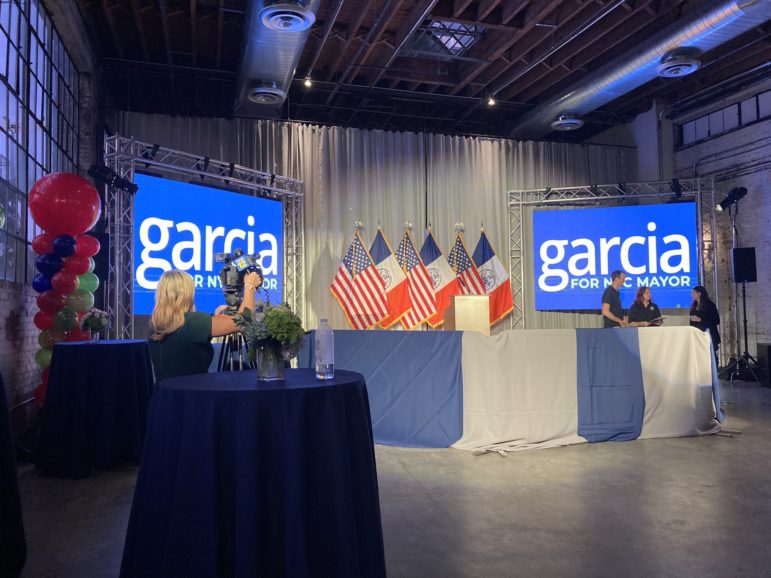
Kathryn Garcia’s election night party headquarters, at an industrial-style venue in Bushwick. 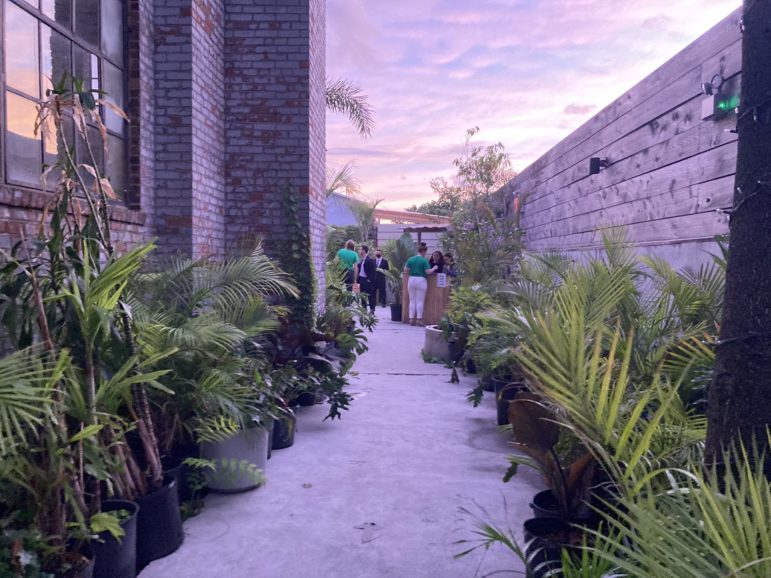
The outdoor portion of Garcia’s election night headquarters. 
Andrew Yang’s campaign at the rooftop at Yotel Hotel in Manhattan. 
Supporters mingle at Yang’s campaign party. 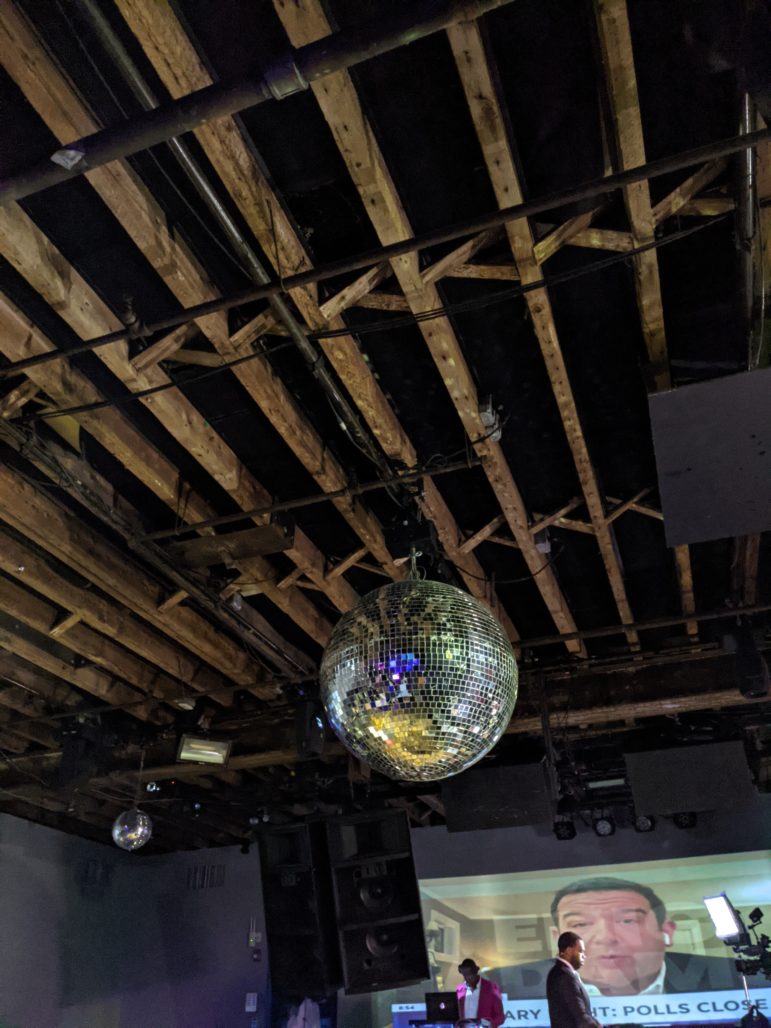
Brooklyn Borough President Eric Adams’ party is at a disco-ball adorned club in Williamsburg called Schimanski. 
A supporter samples the food spread at Maya Wiley’s election night party.
–Ese Olumhense, David Brand, Jeanmarie Evelly, Adi Talwar
Hoping for the First Woman at City Hall
Gloriana Davis, of St. Albans, said she doesn’t pay too much attention to politics but wanted to vote to fulfill her civic duty and to choose women for mayor and City Council. She said she wrote down the names of her preferred candidates and brought the list into the booth with her before her first ranked-choice voting experience at P.S. 15 in Queens.
“It was different, but I’m glad I did it, and I’m glad I could vote for all women.”
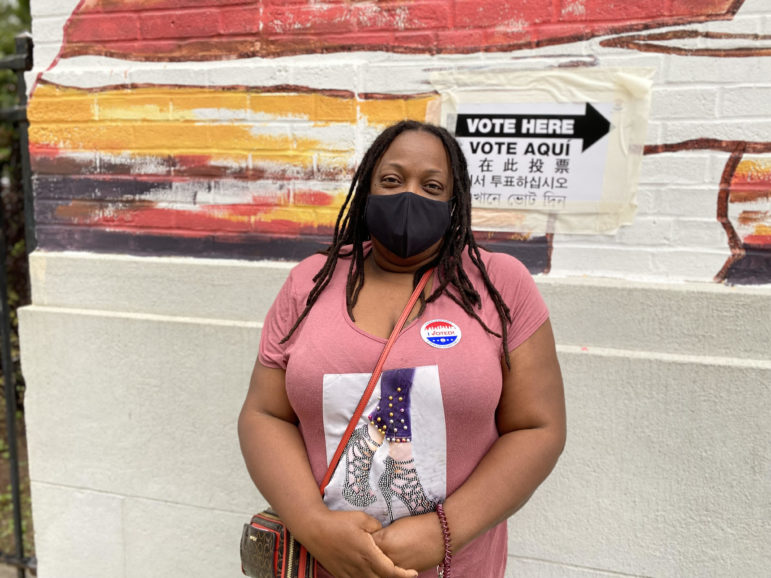
David Brand
Gloriana Davis of St. Albans voted at PS 15, the Jackie Robinson School.Ron Tremba, who voted on the Upper East Side, said the possibility of the city’s first female mayor was on his mind when he cast his ballot for Kathryn Garcia. “It’ll be nice to have a change,” he said. “Garcia has tapped into something, and people have responded to her — her lack of drama and her steady, solid confidence.”
Tremba also felt that Garcia was a moderate choice that would have strong bipartisan cooperation. “Someone who is too far out of the mainstream can be divisive and make it hard to get things done,” he said.
Why They Voted: Crime, Housing & COVID Recovery
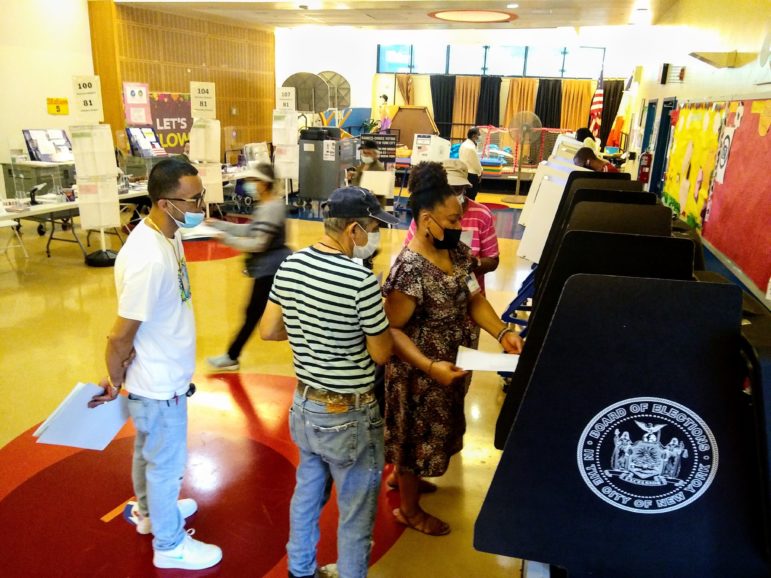
Adi Talwar
Voters cast ballots at S 94 in the Norwood section of the Bronx.Voting got off to a slow start at Taft High School in the west Bronx early Tuesday morning. Inside the school’s gym, where a row of voting kiosks had been set up, poll workers greatly outnumbered voters.
For some in the community, which is home to a high number of immigrants, recent violence helped drive them to the polls, they told City Limits. Last week, a shooting on Sheridan Avenue, where the school is located, left one man wounded. Two children, who stood feet from the gunman during the attack, were seen on video ducking from the bullets. Outside the high school Tuesday, police posters seeking information on the shooter, who was not arrested, marked nearby poles.
Esther Murray, a city employee who cast her ballot at Yorkville Community School on Manhattan’s Upper East Side, agreed that crime was a big issue for her this election as well. “We need police,” she said. “It would be bad to defund the police.”
She was joined outside the poll site by Kenny Levitt, who agreed that defunding police was “out of the question.” He said that support for public schools over charter schools was a sticking point for him. He voted for Maya Wiley, impressed by her endorsements from Congresswomen Alexandria Ocasio-Cortez and Senator Elizabeth Warren. His second choice was Kathyrn Garcia.
Bernardino Santos, 53, arrived Tuesday morning at the poll site at P.S. 85 in Astoria. Though he wasn’t able to vote in the primary—he’s not registered with a specific party—he was rooting for Eric Adams as his top choice and Maya Wiley as his second.
“I like the strength he has for the Black Lives Matter movement. He is a strong candidate to face police brutality,” says Santos, who has lived in Astoria for more than 30 years. Wiley, he added, “is a strong woman” and he said he likes her economic plans.
At P.S. 119 in the southeast Bronx, an area home to a mix of ethnic groups including large populations of immigrants from Bangladesh and Latin America, voters said issues like COVID-19 recovery, health care, mental health, housing and crime were among the most important to them.
“I vote because I need someone to stay in a position of authority, to help meet the needs of those who are in need,” said Mary Samuels, who showed up on Tuesday with her daughter.
For others, like Roman Perez, the school’s basketball coach, choosing candidates for office was a little easier. Perez has decided not to vote for any career politicians, he said. “The main thing is change,” said Perez, who is supporting businessman Ray McGuire for mayor. “People wanna see something different.” McGuire is his first and only choice for mayor.
“This man can be a game changer,” he said.
–Ese Olumhense, Liz Donovan, Daniel Parra
Poll Site Shortages: Missing Translators, ‘A Table With Nobody’
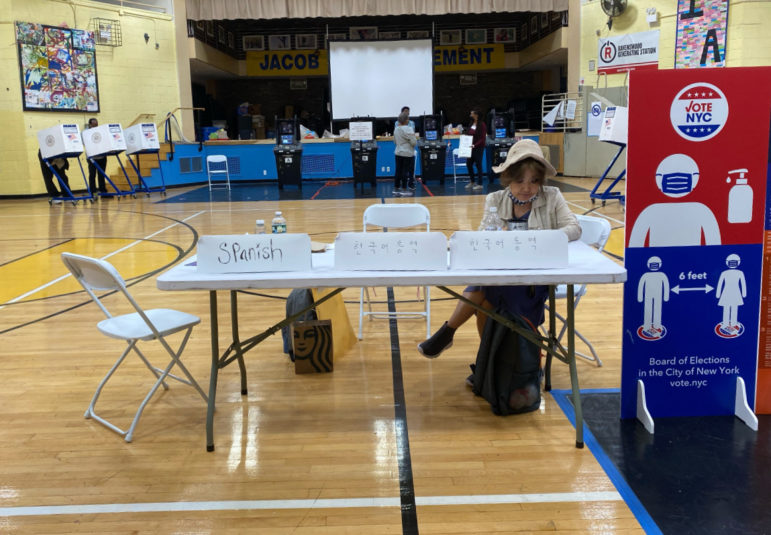
David Brand
The polling place at Queensbridge Houses, where Spanish and Chinese-language translators had yet to show up on the morning of primary day.
At the Jacob Riis Settlement poll site in the Queensbridge Houses, a table was set up Tuesday morning to offer translation services for voters. But some chairs sat empty: two of the three Board of Elections translators slated to serve the site—its Spanish-language and Chinese-language interpreters—had yet to show.
Poll site coordinator Margaret Johnson said they notified BOE of the snafu. “They told us there’s nothing they can do. They don’t have any more,” Johnson said. “We’re trying the best we can.”
Poll workers were giving out information cards in seven languages to try to fill the gaps. The lone interpreter at the site Tuesday morning, who was providing translation services in Korean, was using Google Translate in an attempt to assist voters, who are being asked to vote differently this year under the city’s new ranked choice voting system.
“They need to fix this,” Queensbridge Houses Tenants Association President April Simpson told City Limits. “We’re the largest housing development in the United States.”
The BOE did not immediately respond to a request for comment.
Other city poll sites were also experiencing some worker shortages Tuesday. A handful of early risers were already at the polls shortly after they opened at 6 a.m. at Yorkville Community School on Manhattan’s Upper East Side. Coordinator Brenda Richards weaved through the stations set on a bright chartreuse floor, counting volunteers and talking into her cell phone with a medical mask slung across her chin. “We have only one person at each table, and a table with nobody,” she said. “Send 10 people.”
At 6:20, a volunteer flagged her down. “We have a ballot jam,” the volunteer told her. “Already?” Richards responded, reaching again for her cell. “Come on, y’all!”
By 8 a.m., the site was bustling with a steady stream of voters but without a wait time. Richards reported that the broken scanner had been fixed and everything was functioning smoothly. The requested 10 poll workers, though, had still not arrived.
“The main thing I need is the people,” she said.
–David Brand, Liz Donovan
‘I Don’t See the Point in That’: NYers React to Ranked Choice Voting
Tuesday’s primary is the first citywide use of ranked choice voting, which allows New Yorkers to choose up to five candidates in each race and rank them in order of preference. But not everyone is embracing the new system.
“I’m very definite on who I want to vote for. I’ve been voting since I was 18 and I’m going to be 54 in another month. So for me it’s not about choice—I know who I want to vote for and I voted for them,” said Thomas Smith, who was casting his ballot at PS 94 in the Norwood section of the Bronx. “I don’t see the point in that. I mean, it’s a nice thought, but no, it’s a waste.”
Others, though, said they liked ranked choice voting and and found it straightforward. One couple in Manhattan said it prompted them to do more research on the candidates than they normally would.
–Adi Talwar
Voters—and a Candidate—Turn Out Early in Ravenswood
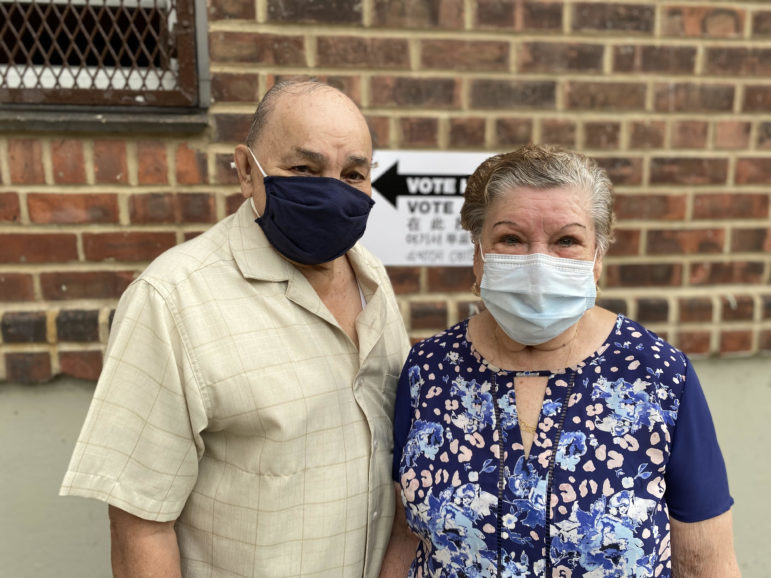
Married couple Maya and Delia Gonzalez left the Ravenswood Houses poll site around 8:10 a.m after casting their ballots for Eric Adams. “We always vote,” she said. 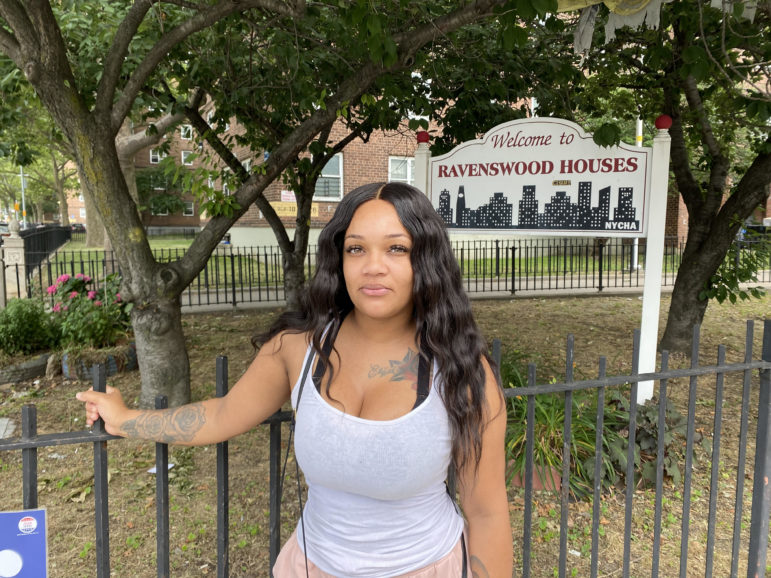
Amanda Spigner, a city worker, voted with her son in Ravenswood. She said she cast her vote for Adams and picked Lorenzo Brea for City Council Distrct 26. 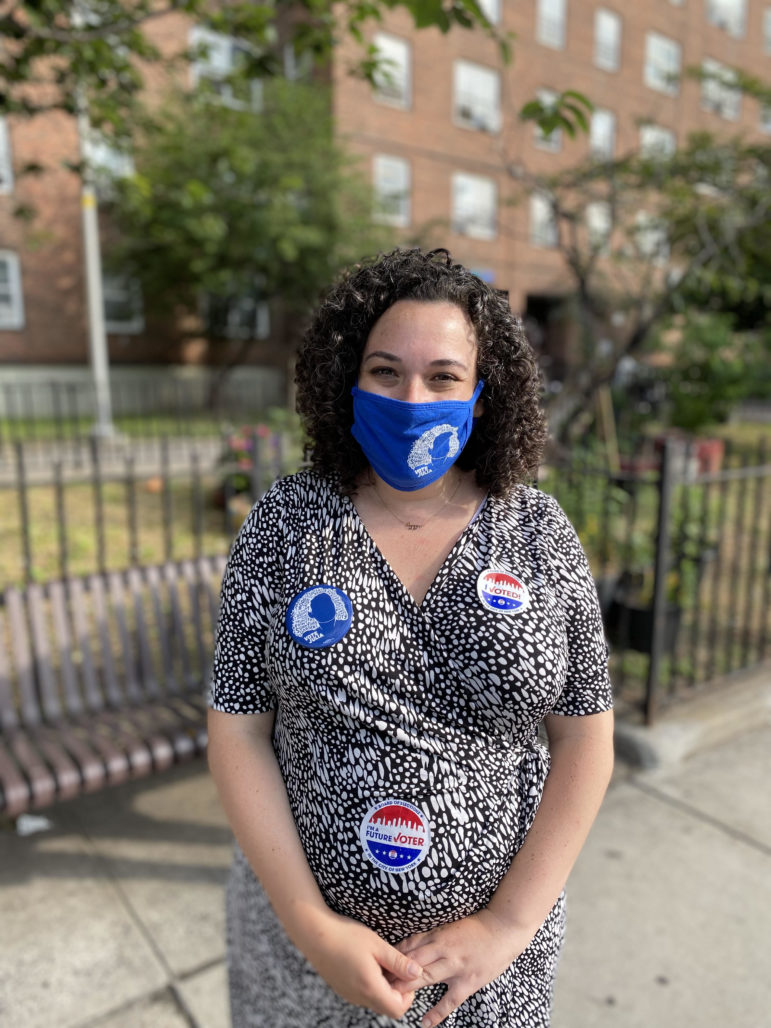
District 26 candidate Julia Forman stood outside a bus stop near the Ravenswood poll site.
By 8 a.m., about 50 people had voted at the Ravenswood Houses Community Center in Queens, according to the polling site coordinator. The eight people filling out their ballots were nearly outnumbered by campaign workers standing 100 feet from the polling place entrance in a district with more Council candidates than anywhere else in New York City.
Among them is District 26 candidate Julia Forman, who stood outside a bus stop near the poll site while campaign staffers for rival candidates Lorenzo Brea, Amit Bagga, Brent O’Leary and Hailie Kim stood near the entrances.
Married couple Maya and Delia Gonzalez left the polling place around 8:10 a.m after casting their ballots for Eric Adams. They declined to say who they picked for Council. No single issue motivated them to vote today, said Maya Gonzalez.
“We always vote,” she said.
Jasmine John, another Ravenswood resident, shared a similar perspective. “It’s my civic duty,” she said, but declined to say who voted for. Amanda Spigner, a city worker, stopped by the polling place with her son on the way to his school in Jamaica. She said she cast her vote for Adams and picked Lorenzo Brea for Council.
–David Brand
Early Lines in Prospect Lefferts Gardens
By 6:10 a.m., a line of voters was already snaking down the block outside PS 320/375 in Prospect Lefferts Gardens, Brooklyn. The crowds cleared shortly after, however, with the exception of canvassers campaigning for their candidates outside.
–Megan Fu


